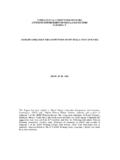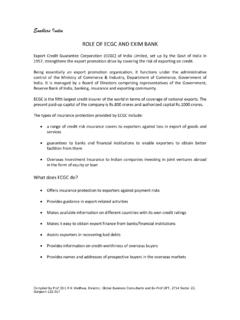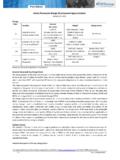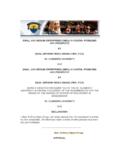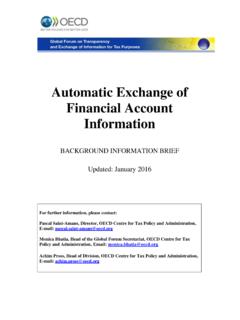Transcription of bhar 393 410 - World Bank
1 39320 The Role of the InternationalFinancial Institutionsin Addressing GlobalIssuesVINAYBHARGAVAA ddressing the many global issues discussed in this volume will requireinternational cooperation in the economic as well as the politicalsphere. The key global institution mobilizing political cooperation amongnations on these issues is the United Nations (UN) system, discussed inchapter 19. Mobilization of economic and financial cooperation, includingissues related to the transfer of resources, is one of the key responsibilities ofthe international financial institutions (IFIs). Together, the UN and IFIs makeup the bulk of the global governance system in place today. This chapter pro-vides an overview of IFIs, the role they play in addressing global issues, andthe main current proposals to improve their Financial Institutions: An OverviewIFIs are institutions that provide financial support and professional advicefor economic and social development activities in developing countriesand promote international economic cooperation and stability.
2 The termThe information for this chapter is based mostly on publicly available materials on the Web sites ofthe International Monetary Fund, the World bank , and the regional development banks. Informationabout the global programs is based on the Annual Global Monitoring Reports. These contributionsare gratefully 8/14/06 7:50 PM Page 393international financial institutiontypically refers to the International Mone-tary Fund (IMF) and the five multilateral development banks (MDBs): theWorld bank Group, the African development bank , the Asian DevelopmentBank, the Inter-American development bank , and the European bank forReconstruction and development . The last four of these each focus on a sin-gle World region and hence are often called regional development banks. IMFand the World bank , in contrast, are global in their scope; they are also spe-cialized agencies in the UN system but are governed independently of it. All IFIs admit only sovereign countries as owner-members, but all arecharacterized by a broad country membership, including both borrowingdeveloping countries and developed donor countries; membership in theregional development banks is not limited to countries from the region butincludes countries from around the World .
3 Each IFI has its own independentlegal and operational status, but because a considerable number of countrieshave membership in several IFIs, a high level of cooperation is maintainedamong speaking, IMF provides temporary financial assistance to membercountries to help ease balance of payments adjustment. MDBs providefinancing for development to developing countries through the following: Long-term loans (with maturities of up to 20 years) based on marketinterest rates. To obtain the financial resources for these loans, MDBsborrow on the international capital markets and re-lend to borrowinggovernments in developing countries. Very-long-term loans (often termed credits, with maturities of 30 to40 years) at interest rates well below market rates. These are fundedthrough direct contributions by governments in the donor countries. Grant financing is also offered by some MDBs, mostly for technicalassistance, advisory services, or project preparation.
4 All IFIs are active in supporting programs that are global in scope, in addi-tion to their primary role of financing and providing technical assistance toprograms at the country level. Their global activities are discussed later in thechapter. Several other publicly owned international banks and funds also lend todeveloping countries, and these are often grouped together as other multilat-eral financial institutions rather than as IFIs. They usually have a relativelynarrow ownership or membership structure or focus on particular sectors oractivities. Among these are the European Investment bank , the InternationalFund for Agricultural development , the Islamic development bank ,Global Issues for Global 8/14/06 7:50 PM Page 394the Nordic development Fund and the Nordic Investment bank , and theOrganization of the Petroleum Exporting Countries Fund for InternationalDevelopment. A number of subregional banks established for development purposes arealso classified as multilateral banks rather than as IFIs, as they are owned by agroup of countries (typically borrowers and not donors).
5 Among these are theCorporaci n Andina de Fomento (Andean development Corporation), theCaribbean development bank , the Central American bank for EconomicIntegration, the East African development bank , and the West African Devel-opment bank . Some other international institutions, such as the bank for InternationalSettlements, the Financial Stability Forum, and the Basel Committee, alsoperform important roles in the international financial system but are notinvolved in lending. These, too, are not counted among IFIs and are not dis-cussed in this chapter, which discusses IMF and MDBs International Monetary FundIMF was established by international treaty in 1945 as the central institutionof the international monetary system the system of currency trading andexchange rates that enables business to take place between countries with dif-ferent currencies. IMF aims to prevent crises in the system by encouragingcountries to adopt sound economic policies and monitoring their adherenceto such policies; it is also as its name suggests a fund that can be tappedby members needing temporary financing to address balance of paymentsproblems.
6 More specifically, IMF s statutory purposes include promoting the bal-anced expansion of World trade, the stability of exchange rates, the avoidanceof competitive currency devaluations, and the orderly correction of balanceof payments problems. To serve these purposes, IMF engages in three types ofactivities: (a) it monitors economic and financial developments and policies,both in its member countries and at the global level, and offers policy adviceto its members based on its more than 50 years of experience; (b) it lends tomember countries experiencing balance of payments problems, not just toprovide temporary financing but also to support economic adjustment andreforms aimed at correcting the underlying problems; and (c) it provides thegovernments and central banks of its member countries with technical assis-tance and training in its areas of expertise. Headquartered in Washington, , IMF is governed by its almost-globalmembership of 184 countries.
7 IMF is also the principal forum for discussingThe Role of the International Financial Institutions in Addressing Global Issues 8/14/06 7:50 PM Page 395not only national economic policies in a global context but also issues impor-tant to the stability of the international monetary and financial system. Theseinclude countries choice of exchange rate arrangements, the risks of destabi-lizing international capital flows, and the design of internationally recognizedstandards and codes for policies and institutions. The World bank GroupFounded in 1945 at the same international conference as IMF, the WorldBank at first was involved mainly in the reconstruction of countries devas-tated by World War II. As those countries recovered, the bank turned itsprimary focus to the second task envisioned for it, namely, the economicdevelopment of the World s nonindustrialized countries, with the goal oflifting the World out of poverty.
8 The World bank is organized much like a cooperative, whose sharehold-ers are the same 184 countries that make up IMF s membership. The share-holding countries are represented by a Board of Governors, which is theBank s ultimate policy making body. As a rule, the governors are membercountries ministers of finance or of development . Because they meet onlyannually, the governors delegate much of the bank s decision making to 24executive directors, who work on site at the bank . The governors have alsoestablished a development Committee at the ministerial level. The commit-tee s task is to facilitate intergovernmental consensus building on develop-ment issues, as well as to advise the boards of governors of both the bank andthe IMF on critical development issues and on the financial resourcesrequired to promote World bank Group, which is headquartered in Washington, , ismade up of five institutions: the International bank for Reconstruction andDevelopment (IBRD), the International development Association (IDA), theInternational Finance Corporation (IFC), the multilateral Investment Guar-antee Agency (MIGA), and the International Centre for Settlement of Invest-ment Disputes (ICSID).
9 Each institution plays a different but important rolein the group s corporate mission of reducing global poverty and improvingliving standards in the developing World . Together, they provide low-interestloans, interest-free credits, and grants to governments and the private sectorin developing countries for investments in education, health, infrastructure,communications, and many other purposes, as well as services in support ofthose investments. IBRD focuses on middle-income countries and creditworthy low-incomecountries, whereas IDA focuses on the poorest countries in the World . IBRDG lobal Issues for Global 8/14/06 7:50 PM Page 396lends only to governments, financing these loans primarily by selling triple-A-rated bonds in the World s financial markets. Although IBRD earnsa small margin on this lending, the greater proportion of its income comesfrom lending out its own capital. This capital consists of reserves built up overthe years and money paid in from the World bank s shareholders.
10 Thisincome also pays the World bank s operating expenses, and part of it has beencontributed to IDA and debt relief. IDA is the World s largest source of interest-free loans and grant assistanceto the governments of the poorest countries. Its funds are replenished every3 years by its 40 donor country members. Additional funds are generatedthrough repayments of principal on its 35- to 40-year no-interest loans; thesefunds are then available for re-lending. IDA lending amounts vary from yearto year but generally account for about 40 percent of total World bank Grouplending. IFC focuses on financing private sector projects, in which it may take anequity stake in addition to lending. MIGA promotes foreign direct investmentin developing countries by insuring investors against political or noncom-mercial risks in those countries. ICSID provides a forum for mediating dis-putes between investors and governments and advises governments in theirefforts to attract Inter-American development BankThe Inter-American development bank (IDB) was established as a develop-ment institution in 1959, which makes it the oldest of the regional developmentbanks.










